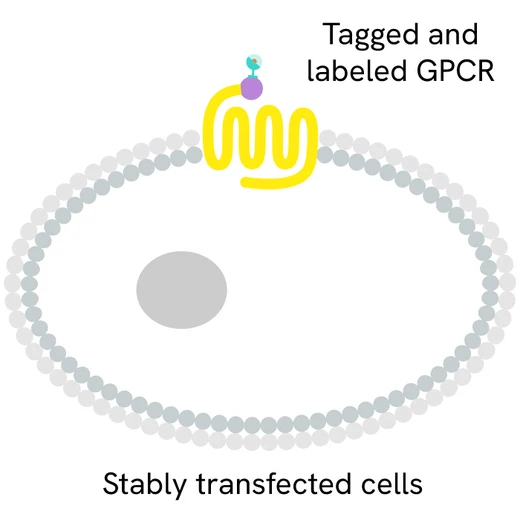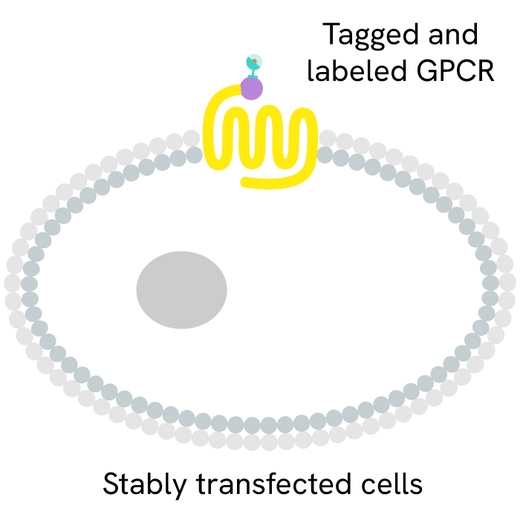

Tag-lite Adenosine A3 receptor Frozen & Labeled Cells, 200 Assay Points








| Feature | Specification |
|---|---|
| Application | Receptor-Ligand Binding |









Loading...
Product information
Overview
A3 receptor is one of the four adenosine receptor family (including A1, A2A, and A2B receptors). A3 receptor is implicated in various pathological conditions, such as cardiac and cerebral ischaemia, and neurodegenerative diseases, as well as inflammatory pathologies including rheumatoid arthritis and asthma. Thus, it is considered as an interesting therapeutic target.
Cells expressing the A3 receptor are provided pre-labeled with Terbium, and can be used to conduct receptor binding studies on the aforementioned receptor.
How it works
Assay principle
Running your A3 receptor binding assay using Tag-lite is as easy as it can get. Simply dispense 10 µL of labeled cells (C1TT1A3) into each well, followed by 5 µL of labeled ligand (L0069GRE) and 5 µL of the compound you wish to test. Like all HTRF assays, Tag-lite assays do not require any washing steps. A diagram of the procedure to be followed is given on the right.

Saturation binding (KD)
A saturation binding assay measures total and non-specific binding for increasing concentrations of ligand under equilibrium conditions. To perform the assay, the fluorescent ligand is titrated into a solution containing a fixed amount of labeled cells, and then incubated to equilibrium. The HTRF Ratio obtained from this titration is the total binding.


Competitive binding (KI)
A competitive binding assay is performed to measure the dissociation constant, Ki. To perform the assay, the compound is titrated into a solution containing a fixed concentration of fluorescent ligand and a fixed amount of cells.


Assay validation
Kd and Ki validation
Examples of data obtained using Adenosine A3 receptor labeled cells and their matching fluorescent ligand (L0069GRE). XAC (Xanthine amine congener) was used for Ki determination in the competitive binding assay. Results may vary from one HTRF® compatible reader to another.


Compound profiling on Adenosine A1, A2A, A2B and A3 receptors
Adenosine receptors designated by four subtypes A1, A2A, A2B and A3 were shown to be promising pharmacological targets for the development of therapeutic compounds for various therapeutic areas such as cancer, neurodegenerative disease and COPD/Asthma. Thus, a wide range of compounds, and particularly antagonists have been largely studied.
The Tag-Lite® binding assay platform offers the complete adenosine receptors subset A1, A2A, A2B and A3 to characterize compounds in term of binding affinity (Ki) and selectivity profile.
The set of compounds have been profiled on A1, A2A, A2B and A3 receptors using their respective fluorescent ligands L0067RED, L0058RED, L0068RED and L0069GRE.The selectivity profiles of several compounds involved in different therapeutic areas were assessed with this Tag-Lite platform.
The table below summarizes the resulting Ki obtained for each receptor subtype for the full panel of compounds. The results are confirming the expected selectivity and the range of affinities for these reference compounds.
| Compound | Pharmacological class | Compounds affinities (Ki - nM) for the different adenosine receptor subtypes | |||
|---|---|---|---|---|---|
| A1 | A2A | A2B | A3 | ||
| XAC | Non selective antagonist | 12 | 15 | 20 | 50 |
| Theophylline | Non selective antagonist | 4000 | 5000 | 18000 | 14000 |
| DPCPX | A1 antagonist | 7.6 | 170 | 145 | 800 |
| Vipadenant | A2A antagonist | 70 | 0.9 | 55 | 20000 |
| Ciforadenant (CPI-444) | A2A antagonist | 150 | 3.4 | 660 | 1600 |
| Preladenant (SCH 420814) | A2A antagonist | >20000 | 5 | >20000 | >20000 |
| Istradefylline (KW-6002) | A2A antagonist | >10000 | 40 | >10000 | >10000 |
| ZM241385 | A2A antagonist | 260 | 0.7 | 40 | 750 |
| AZD4635 | A2A antagonist | 900 | 15 | 660 | >10000 |
| MRS1706 | A2B inverse agonist | 150 | 325 | 30 | >300 |
| MRS1220 | A3 antagonist | 325 | 37 | >500 | 1.6 |



The graphs show the pattern of the dose-response curves obtained for five compounds displaying different selectivity profile


Specifications
| Application |
Receptor-Ligand Binding
|
|---|---|
| Brand |
Tag-lite
|
| Detection Modality |
HTRF
|
| Product Group |
Cells
|
| Shipping Conditions |
Shipped in Dry Ice
|
| Target Class |
GPCR
|
| Technology |
TR-FRET
|
| Therapeutic Area |
Cardiovascular
Infectious Diseases
Inflammation
Metabolism/Diabetes
NASH/Fibrosis
Neuroscience
Oncology & Inflammation
Rare Diseases
|
| Unit Size |
200 assay points
|
Video gallery
Resources
Are you looking for resources, click on the resource type to explore further.
G-protein coupled receptors (GPCRs) are crucial transmembrane proteins involved in cellular signal transduction.
This technical...
Discover the versatility and precision of Homogeneous Time-Resolved Fluorescence (HTRF) technology. Our HTRF portfolio offers a...
This guide provides you an overview of HTRF applications in several therapeutic areas.
Tag-lite™ is a cell-based, no-wash alternative to traditional radioisotope assays for studying GPCR-ligand interaction.
Adenosine...


How can we help you?
We are here to answer your questions.






























